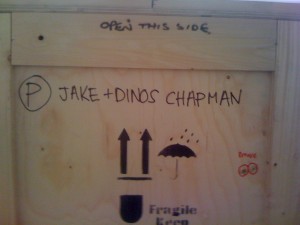The artistic director of this year’s Biennale of Sydney David Elliot has curated a show with a mouthful of a title – THE BEAUTY OF DISTANCE: Songs of Survival in a Precarious Age. As the BOS’s website explains “the idea of distance expresses the condition of art itself. Art is of life, runs parallel to life and is sometimes about life. But, for art to be art (a medium of numinous, sometimes symbolic power), it must maintain a distance from life…” Andrew Frost spoke to Elliott about this ambitious show and found that the director’s aims are both humble – and direct.
Are you sitting comfortably?
David Elliott: Yes, just waiting for a coffee – soy latte please.
How did you go about selecting work for the Biennale of Sydney – was it theme first or did the theme emerge from the selection?
DE: I was asked to pitch an idea to the board. I pitched it and had some artists in the back of my mind. I didn’t really want to give artists names at that time. It was more about describing a situation and an idea behind the Biennale. Once that was in place it was about putting some flesh on those bones. But I did have fairly clear of idea of some of the directions would take and what the realm of research would be about for things I didn’t know about. It was that kind of process.
Was this an idea that you’d had for awhile or was it one that you formulated when the opportunity to curate the Biennale came along?
DE: It was formulated the Biennale but it related to two other large exhibitions which were in their way a reflection of a place and time. But they were also about the condition of art as I regarded of it. The first was Wounds: Between Democracy and Redemption in Contemporary Art and that opened in Stockholm in 1998. That was a little more historical in its outlook as it looked at the collection. The show looked at how art is made at the point of fracture, rupture or disjuncture – Stockholm being the home of Ingmar Bergman and this kind of self-loathing Lutheran heritage which was supposed to be amazingly liberated – but wasn’t. The second show was Happiness: A Survival Guide for Art & Life which was the first show I made in Tokyo. That was looking at East and West and different traditions over a much wider historical time span because it would include contemporary and historical works, it put contemporary work of art from 5th century China, 12th century Japan, Khmer sculpture of the 10th century, next to Robert Ryman and Bill Viola. The exhibition was structured through four continents of “happiness” – Arcadia, Nirvana, Desire, and Harmony. It had Matisse in it, Manet, there was painting from Mao’s China, Jeff Koons, Leni Riefenstahl, Dziga Vertov, Peter Blake.
With the better known artists you’ve included in the Biennale of Sydney, and perhaps with these other shows, is there a thought about their “brand name” status, or ability to “pull crowds”?
DE: I look at it another way. I select them because I like the work and they are really important artists, and have done for awhile. And doing a big thematic show it’s important to offer a range of age – and acceptance – and show these things against art that isn’t so well known. You’re making a point that the market isn’t the only thing. The market is completely irrelevant to what I do.
For artists like Jake and Dinos Chapman or Louise Bourgeois – they’re very well known – and their work sits alongside others who may not be all that well known even within their own country. The dialogue between those art works is an interesting counterpoint…
DE: The only reason I’ve chosen any work is that I think it’s really good. It does give people who haven’t been travelling around the chance to measure up. And that’s an important part of the Biennale, that you shouldn’t disregard anything local or in the region. You should include them if they’re good enough.
Do you think it’s a reasonable expectation of Australian art audiences that there should be a certain representation?
DE: I think it’s reasonable, yes absolutely. I don’t think it’s about representing Australia. From my point of view, no matter where you are, if you look you’ll find really good work. It’s about spending the time and working on it. Of course, in the context of an exhibition you’re setting up an argument and ideas about how things fit together, so it’s important to make that work. There are plenty of good artists who aren’t in the show for any number of reasons. The show can’t be infinitely expandable. This show isn’t the final word on anything – it’s just trying to be a good show.
The mix of artists across generational lines is very interesting – Aleks Danko and Rodney Glick and Peter Hennessy and Brook Andrew, for example.
DE: Well look at Brodie Ellis who’s not yet 30. I saw some of her work and really liked them. Thought she was bright and very intelligent and a certain way of looking at things, and a dogged determination which you need if you’re going to make good work. I haven’t seen her new piece yet and she really had to go out on a line to make this in every way possible. She took herself to Japan to shoot the eclipse last year and I have every confidence she’ll make a great work.
The themes and the titles of this Biennale are very rich and perhaps a little dense in their allusions – what are you hoping that this show will do for the visitor, what will the draw from it?
DE: If they’re already interested in contemporary art, I hope they’ll become more interested and realise that there’s a lot more than they might have realised before. If not, I hope it will hook ‘em, and never let ’em go.



Pingback: Tweets that mention New blog post: Never let 'em go: David Elliott on the 2010 Biennale of Sydney -- Topsy.com
It’s admirable that Elliot is so straightforward in saying he wants to make a good show. It’s a refreshing change from the intellectual obfuscation that goes on with curators. Look forward to seeing if the Biennale does hook me in.
Most curators make stratospheric claims for the importance of art and exhibitions. I was pleased to read that Elliott just wanted to make a good show. Such honesty is refreshing. That was my point.
Brodie Ellis is a terrific artist and how wonderful to see she is featured in the BoS. I included her in an exhibition I curated for the Melbourne Fashion Festival when she was still only a second year Undergraduate student at VCA. Even then, her talent, drive and ambition were apparent.